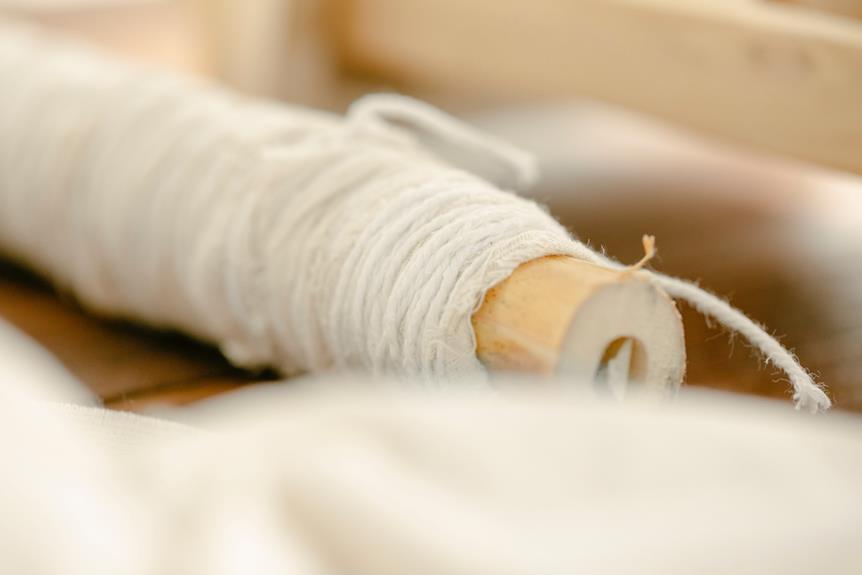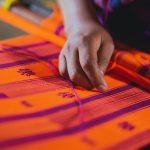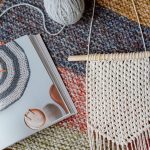When it comes to choosing the right yarn twist for your fabric, it's like selecting the perfect seasoning for a dish – it can truly make or break the final product.
Understanding which twist type will best suit your fabric is crucial for achieving the desired strength, appearance, and drape.
In this guide, we will delve into the impact of S-twist and Z-twist yarns, the best twist for enhancing fabric strength, and how to choose the ideal twist for achieving the desired appearance.
By mastering the nuances of yarn twist types, you can elevate your fabric creations to a whole new level of craftsmanship.
Key Takeaways
- Yarn twist (S-twist and Z-twist) affects the appearance, strength, and texture of fabric.
- Selecting the right yarn twist is important for specific fabric applications and desired characteristics of the final fabric.
- A tighter twist results in a stronger yarn, making high twist yarns suitable for fabrics that undergo wear and tear.
- The direction of twist creates different visual effects on the fabric's surface and significantly influences fabric texture and drape.
Understanding Yarn Twist Basics
Why is yarn twist important for creating quality fabric?
Yarn twist terminology refers to the direction and amount of twist in a yarn. This is a fundamental aspect of yarn production that greatly influences the characteristics and performance of the final fabric. Understanding yarn twist basics is crucial for anyone seeking mastery in the textile industry.
The yarn twist direction can be either S-twist or Z-twist. In S-twist, the yarn is twisted in a way that the fibers move in a diagonal line from the top left to the bottom right, while in Z-twist, the fibers move from the top right to the bottom left. This terminology may seem intricate, but it's essential in comprehending the behavior of different yarns in fabric construction.
The yarn twist plays a significant role in the appearance, strength, and texture of the fabric. It affects how the fibers hold together and influences the drape and resilience of the material. Therefore, understanding yarn twist basics empowers you to make informed decisions when selecting yarns for specific fabric applications.
Impact of S-Twist and Z-Twist
You frequently encounter fabrics with either S-twist or Z-twist yarns, and understanding the impact of each twist type will help you make informed choices for your textile projects.
When it comes to the impact of S-twist and Z-twist yarns on fabric, several factors come into play, including spinning techniques and fiber properties. Here's what you need to know:
- Spinning Techniques: The direction of twist, whether S or Z, affects how the fibers are bound together. S-twist yarns are created by spinning the fibers in a counterclockwise direction, while Z-twist yarns are spun in a clockwise direction. This difference influences the behavior of the yarns during weaving or knitting, affecting the overall structure and drape of the fabric.
- Fiber Properties: The type of fiber used also interacts with the twist of the yarn. Natural fibers like cotton or wool may respond differently to S-twist and Z-twist due to their inherent properties, impacting the fabric's strength, elasticity, and even its appearance.
Understanding the impact of S-twist and Z-twist yarns allows you to select the most suitable yarn for your specific project, ensuring the desired characteristics and performance of the final fabric.
Best Yarn Twist for Strength
To ensure the strength of your fabric, consider the twist direction of the yarn, as it directly impacts the binding of fibers and overall durability.
When it comes to yarn twist durability, the direction of the twist plays a significant role. The twist direction influence is crucial in determining the strength of the fabric.
In general, a tighter twist tends to result in a stronger yarn, as it holds the fibers together more securely. For maximum strength, a high twist yarn is recommended, especially for fabrics that will undergo a lot of wear and tear.
Additionally, a balanced twist, where the S-twist and Z-twist are equal, can also contribute to the overall strength of the fabric.
Choosing Yarn Twist for Appearance
When selecting yarn twist for appearance, consider how the twist direction and level of twist will impact the visual texture and drape of your fabric. Yarn twist aesthetics play a crucial role in determining the overall look and feel of the fabric. Here are some key factors to consider when choosing yarn twist for appearance:
- Direction of Twist: The direction of the yarn twist, whether it's S-twist or Z-twist, can create different visual effects on the fabric's surface. S-twist yarns often lend a smoother appearance, while Z-twist yarns can add more texture and definition to the fabric.
- Level of Twist: The level of twist in the yarn can significantly influence the fabric texture. A higher twist level generally results in a crisper, more defined fabric texture, while a lower twist level tends to create a softer, more relaxed drape.
- Yarn Composition: The type of fiber used in the yarn can interact with the twist to produce specific aesthetic effects. For example, a high-twist yarn made from wool may create a more sculptural fabric texture, while a high-twist cotton yarn may yield a more structured appearance.
- Fabric Weight and Drape: Consider how the yarn twist will contribute to the overall weight and drape of the fabric. A balanced twist may offer a versatile option for achieving a balanced drape, while an over-twisted or under-twisted yarn can impact the fabric's behavior.
Understanding how yarn twist affects fabric texture and appearance can empower you to make informed choices when selecting yarns for your projects.
Drape Considerations for Yarn Twist
Consider the fabric's desired drape when determining the appropriate yarn twist for your project. The fabric's drape refers to how it hangs or falls, and this characteristic is influenced by the yarn twist direction. To help you understand the impact of yarn twist on fabric drape, let's explore the relationship between these factors in a clear and concise manner.
| Yarn Twist Direction | Fabric Drape |
|---|---|
| Z-twist (clockwise) | Soft and fluid |
| S-twist (counter-clockwise) | Crisp and structured |
When the yarn twist direction is Z-twist (twisted clockwise), the resulting fabric tends to have a soft and fluid drape. This type of drape is often desired for garments like flowing dresses or lightweight scarves. On the other hand, when the yarn twist direction is S-twist (twisted counter-clockwise), the fabric drape is typically crisp and structured. Fabrics with this type of drape are well-suited for tailored garments such as shirts or suits. By carefully selecting the yarn twist direction, you can effectively control the drape of your fabric to achieve the desired aesthetic and functionality for your project.
Frequently Asked Questions
Can Different Yarn Twist Types Affect the Texture or Feel of the Fabric in Addition to Appearance and Strength?
Different yarn twist types can indeed affect the texture, feel, appearance, and strength of the fabric. They play a crucial role in determining the elasticity and stretchiness of the fabric, impacting its overall performance and characteristics.
Are There Any Specific Fabric Applications Where a Certain Yarn Twist Type Is Preferred Over Others?
In specific fabric applications, certain yarn twist preferences are vital. The yarn twist impacts fabric texture, making it crucial to choose the right twist type for your desired application. Different twists offer unique benefits for specific uses.
How Does Yarn Twist Type Impact the Elasticity or Stretchiness of the Fabric?
Yarn twist type significantly impacts fabric elasticity, affecting its stretchiness. A tighter twist enhances elasticity while a looser twist reduces it. This directly influences the drape of the fabric, affecting how it falls and moves.
Are There Any Special Care or Maintenance Considerations for Fabrics Made With Certain Yarn Twist Types?
When it comes to fabrics made with certain yarn twist types, special care and maintenance considerations are essential for ensuring fabric durability. Proper care can help preserve the integrity of the yarn twist and extend the lifespan of the fabric.
Can the Choice of Yarn Twist Type Affect the Color Retention or Dye Absorption of the Fabric?
The choice of yarn twist type can significantly impact color retention and dye absorption in your fabric. It affects the appearance and strength of the fabric, influencing how well it retains and absorbs colors.
- Tetron Fabric for Marine Applications: Durability and Use Cases - June 18, 2025
- Tetron Fabric for Outdoor Furniture: Weather Resistance and Care - June 18, 2025
- Tetron Fabric for Wall Coverings: Style and Application Tips - June 18, 2025






